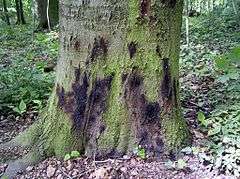Kretzschmaria deusta
Kretzschmaria deusta, commonly known as brittle cinder, is a fungus and plant pathogen found in temperate regions of the Northern Hemisphere. It is common on a wide range of broadleaved trees including beech (Fagus), oak (Quercus), lime (Tilia), Horse Chestnut and maple (Acer). It also causes serious damage in the base of rubber, tea, coffee and palms. It causes a soft rot, initially and preferentially degrading cellulose and ultimately breaking down both cellulose and lignin, and colonises the lower stem and/or roots of living trees through injuries or by root contact with infected trees. It can result in sudden breakage in otherwise apparently healthy trees.[1] The fungus continues to decay wood after the host tree has died, making K. deusta a facultative parasite.[2] The resulting brittle fracture can exhibit a ceramic-like fracture surface. Black zone lines can often be seen in cross-sections of wood infected with K. deusta.
| Kretzschmaria deusta | |
|---|---|
 | |
| Scientific classification | |
| Kingdom: | |
| Phylum: | |
| Class: | |
| Subclass: | |
| Order: | |
| Family: | |
| Genus: | |
| Species: | K. deusta |
| Binomial name | |
| Kretzschmaria deusta (Hoffm.) P.M.D. Martin, (1970) | |
| Synonyms | |
| |
New fruiting bodies are formed in the spring and are flat and gray with white edges. The inconspicuous fruiting bodies persist all year and their appearance changes to resemble asphalt or charcoal, consisting of black, domed, lumpy crusts that crumble when pushed with force. It is inedible.[3]
Gallery
- Kretzschmaria deusta
External links
| Wikimedia Commons has media related to Kretzschmaria deusta. |
References
- Fungal Strategies of Wood Decay in Trees - Schwartze, Engels and Mattheck (2000)
- Rogers, Jack D., Ju, Wu-Ming, Adams, Michael J. "Kretzschmaria: Ecology and Host-Parasite Relationships". Retrieved 2011-05-10.CS1 maint: multiple names: authors list (link)
- Phillips, Roger (2010). Mushrooms and Other Fungi of North America. Buffalo, NY: Firefly Books. p. 376. ISBN 978-1-55407-651-2.